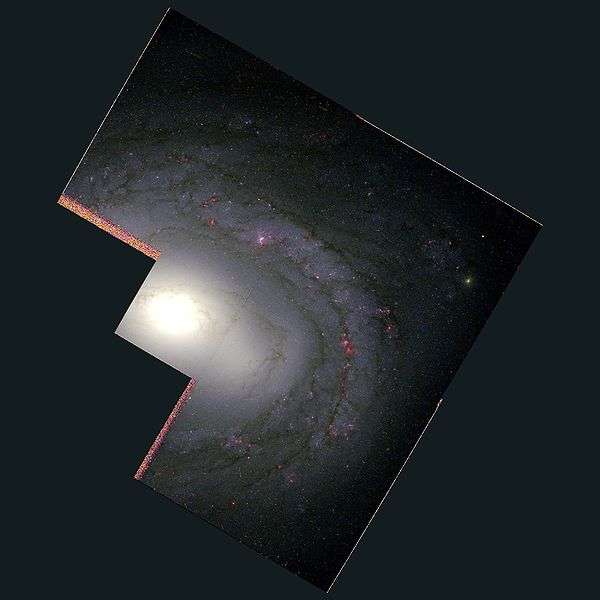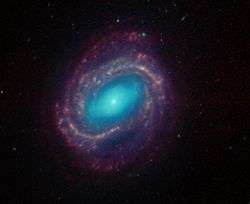Messier 58
| Messier 58 | |
|---|---|
|
| |
| Observation data (J2000 epoch) | |
| Constellation | Virgo[1] |
| Right ascension | 12h 37m 43.5s[2] |
| Declination | +11° 49′ 05″[2] |
| Redshift | 0.00506[2] |
| Helio radial velocity | 1517 ± 1 km/s[2] |
| Distance |
62 Mly (19.1 Mpc) (NED)[3] 68 Mly[4] |
| Apparent magnitude (V) | +10.5[2] |
| Characteristics | |
| Type |
SAB(rs)b; LINER Sy1.9[2] |
| Apparent size (V) | 5′.9 × 4′.7[2] |
| Other designations | |
| NGC 4579, UGC 7796, PGC 42168, VCC 1727, GC 3121[2] | |
Messier 58 (also known as M58 and NGC 4579) is an intermediate barred spiral galaxy with a weak inner ring structure located within the constellation Virgo, approximately 68 million light-years away from Earth.[5][6] It was discovered by Charles Messier on April 15, 1779 and is one of four barred spiral galaxies that appear in Messier's catalogue.[7][8][9][10][11][12] M58 is one of the brightest galaxies in the Virgo Cluster.[13][14] From 1779 it was arguably (though unknown at that time) the farthest known astronomical object until the release of the New General Catalogue in the 1880s and even more so the publishing of redshift values in the 1920s.
Early observations
Charles Messier discovered Messier 58, along with the elliptical galaxies Messier 59 and Messier 60, on April 15, 1779.[10] M58 was reported on the chart of the Comet of 1779 as it was almost on the same parallel as the star Epsilon Virginis.[7][15] Messier described M58 as a very faint nebula in Virgo which would disappear in the slightest amount of light he used to illuminate the micrometer wires.[7][16] This description was later contradicted by John Herschel’s observations in 1833 where he described it as a very bright galaxy, especially towards the middle. Herschel’s observations were also similar to the descriptions of both John Dreyer and William Henry Smyth who said that M58 was a bright galaxy, mottled, irregularly round and very much brighter toward the middle.[7]
.jpg)
Characteristics
Like many other spiral galaxies of the Virgo Cluster (e.g. Messier 90), Messier 58 is an anemic galaxy with low star formation activity concentrated within the galaxy's optical disk,[17] and relatively little neutral hydrogen, also located inside its disk, concentrated in clumps,[18] compared with other galaxies of similar morphological type. This deficiency of gas is believed to be caused by interactions with Virgo's intracluster medium.
Messier 58 has a low-luminosity active galactic nucleus, where a starburst may be present[19] as well as a supermassive black hole with a mass of around 70 million solar masses.[20] It is also one of the very few galaxies known to possess a UCNR (Ultra-Compact Nuclear Ring), a series of star-forming regions located in a very small ring around the center of the galaxy.[21]
Supernovae
Two supernovae have been studied in the M58 galaxy.[2] A type II supernova dubbed as SN 1988A was discovered by Kaoru Ikeya, Robert Evans, Christian Pollas and Shingo Horiguchi on January 18, 1988.[22] It had an apparent magnitude of 13.5 from its center. A Type I supernova dubbed as SN 1989M was then found on June 28, 1989 by Kimeridze.[10] This one had an apparent magnitude of 12.2 from its nucleus.
Hubble view

See also
References
- ↑ R. W. Sinnott, ed. (1988). The Complete New General Catalogue and Index Catalogue of Nebulae and Star Clusters by J. L. E. Dreyer. Sky Publishing Corporation and Cambridge University Press. ISBN 0-933346-51-4.
- 1 2 3 4 5 6 7 8 9 "NASA/IPAC Extragalactic Database". Results for MESSIER 058. Retrieved 2006-10-05.
- ↑ "Distance Results for MESSIER 058". NASA/IPAC Extragalactic Database. Retrieved 2010-04-28.
- ↑ G. Gavazzi; A. Boselli; M.Scodeggio; D. Pierini; et al. (1999). "The 3D structure of the Virgo cluster from H-band Fundamental Plane and Tully-Fisher distance determinations". Monthly Notices of the Royal Astronomical Society. 304 (3): 595–610. arXiv:astro-ph/9812275
 . Bibcode:1999MNRAS.304..595G. doi:10.1046/j.1365-8711.1999.02350.x.
. Bibcode:1999MNRAS.304..595G. doi:10.1046/j.1365-8711.1999.02350.x. - ↑ "Messier 58 Galaxy" (PDF). Solarius. Retrieved 2010-02-09.
- ↑ "M 58 -- LINER-type Active Galaxy Nucleus". SIMBAD. Retrieved 2010-02-23.
- 1 2 3 4 "Messier 58: Observations and Descriptions". SEDS. Retrieved 2010-02-23.
- ↑ Burnham, Robert Jr (1978). Burnham's Celestial Handbook: Volume Three, Pavo Through Vulpecula. Dover. pp. 2086–2088. ISBN 0-486-23673-0.
- ↑ William Liller (1992). The Cambridge guide to astronomical discovery. Cambridge University Press. p. 29. ISBN 0-521-41839-9.
- 1 2 3 "Messier 58". SEDS. Retrieved 2010-02-23.
- ↑ "Oceanside Photo and Telescope". Retrieved 2010-02-28.
- ↑ The other barred spiral galaxies in Messier's catalogue are Messier 91, Messier 95 and Messier 109
- ↑ "Messier Object 58". Archived from the original on 1996-12-25. Retrieved 2006-11-18.
- ↑ "Messier Catalog M51 - M60". SEASKY. Retrieved 2010-02-28.
- ↑ "Charles Messier's Catalog of Nebulae and Star Clusters". SEDS: Charles Messier's Catalog. Retrieved 2010-02-23.
- ↑ "Catalog of Nebulae and Star Clusters.". SEDS: Observed at Paris by M. Messier. Retrieved 2010-02-23.
- ↑ R. A. Koopmann; J. D. P. Kenney (2004). "Hα Morphologies and Environmental Effects in Virgo Cluster Spiral Galaxies". Astrophysical Journal. 613 (2): 866–885. arXiv:astro-ph/0406243
 . Bibcode:2004ApJ...613..866K. doi:10.1086/423191.
. Bibcode:2004ApJ...613..866K. doi:10.1086/423191. - ↑ Cayatte, V.; van Gorkom, J. H.; Balkowski, C.; Kotanyi, C. (1990). "VLA observations of neutral hydrogen in Virgo Cluster galaxies. I - The Atlas". The Astronomical Journal. 100: 604–634. Bibcode:1990AJ....100..604C. doi:10.1086/115545.
- ↑ Contini, Marcella (2004). "The complex structure of low-luminosity active galactic nuclei: NGC 4579". Monthly Notices of the Royal Astronomical Society. 354 (3): 675–683. arXiv:astro-ph/0407379
 . Bibcode:2004MNRAS.354..675C. doi:10.1111/j.1365-2966.2004.08222.x.
. Bibcode:2004MNRAS.354..675C. doi:10.1111/j.1365-2966.2004.08222.x. - ↑ Merloni, Andrea; Heinz, Sebastian; di Matteo, Tiziana (2003). "A Fundamental Plane of black hole activity". Monthly Notices of the Royal Astronomical Society. 345 (4): 1057–1076. arXiv:astro-ph/0305261
 . Bibcode:2003MNRAS.345.1057M. doi:10.1046/j.1365-2966.2003.07017.x.
. Bibcode:2003MNRAS.345.1057M. doi:10.1046/j.1365-2966.2003.07017.x. - ↑ Comerón, S.; Knapen, J. H.; Beckman, J. E. (2008). "Discovery of Four New Ultra-compact Nuclear Rings in Three Spiral Galaxies". Pathways Through an Eclectic Universe ASP Conference Series, Vol. 390, proceedings of the conference held 23–27 April 2007 at Santiago del Teide, Tenerife, Spain. 390: 172. Bibcode:2008ASPC..390..172C.
- ↑ "List of Supernovae". IAU Central Bureau for Astronomical Telegrams. Archived from the original on 11 July 2015. Retrieved 11 July 2015.
External links
| Wikimedia Commons has media related to Messier 58. |
- SEDS Messier: M58
- Spitzer Space Telescope page on Messier 58
- Messier 58 on WikiSky: DSS2, SDSS, GALEX, IRAS, Hydrogen α, X-Ray, Astrophoto, Sky Map, Articles and images
Coordinates: ![]() 12h 37m 43.5s, +11° 49′ 05″
12h 37m 43.5s, +11° 49′ 05″

